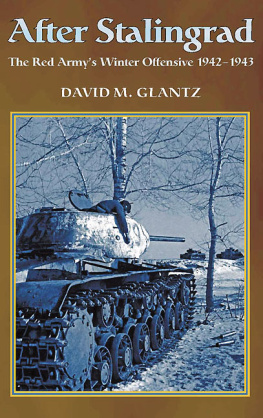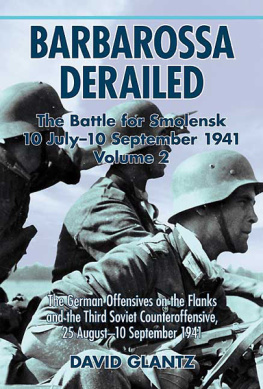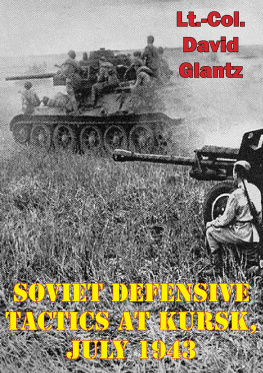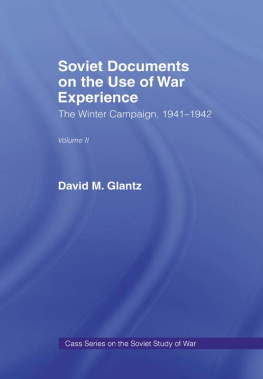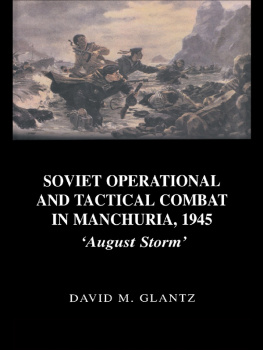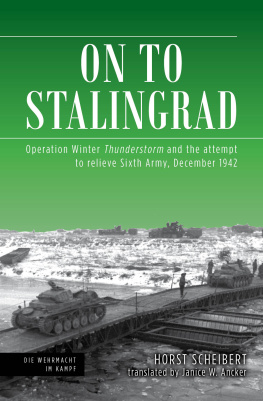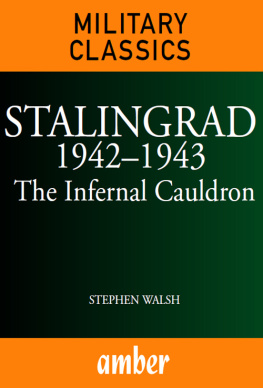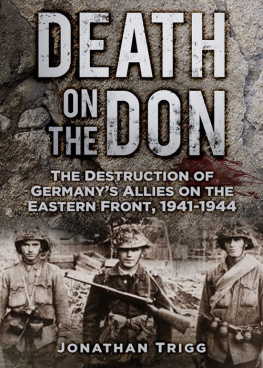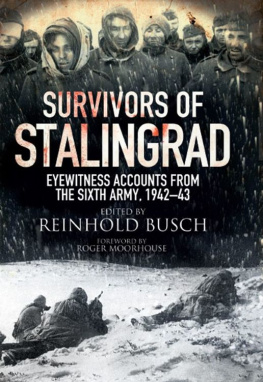Glantz - After Stalingrad: the Red Armys winter offensive, 1942-1943
Here you can read online Glantz - After Stalingrad: the Red Armys winter offensive, 1942-1943 full text of the book (entire story) in english for free. Download pdf and epub, get meaning, cover and reviews about this ebook. City: Solihull;Ukraine;Russia (Federation, year: 2011;2009, publisher: Helion and Company, genre: History. Description of the work, (preface) as well as reviews are available. Best literature library LitArk.com created for fans of good reading and offers a wide selection of genres:
Romance novel
Science fiction
Adventure
Detective
Science
History
Home and family
Prose
Art
Politics
Computer
Non-fiction
Religion
Business
Children
Humor
Choose a favorite category and find really read worthwhile books. Enjoy immersion in the world of imagination, feel the emotions of the characters or learn something new for yourself, make an fascinating discovery.
After Stalingrad: the Red Armys winter offensive, 1942-1943: summary, description and annotation
We offer to read an annotation, description, summary or preface (depends on what the author of the book "After Stalingrad: the Red Armys winter offensive, 1942-1943" wrote himself). If you haven't found the necessary information about the book — write in the comments, we will try to find it.
Glantz: author's other books
Who wrote After Stalingrad: the Red Armys winter offensive, 1942-1943? Find out the surname, the name of the author of the book and a list of all author's works by series.
After Stalingrad: the Red Armys winter offensive, 1942-1943 — read online for free the complete book (whole text) full work
Below is the text of the book, divided by pages. System saving the place of the last page read, allows you to conveniently read the book "After Stalingrad: the Red Armys winter offensive, 1942-1943" online for free, without having to search again every time where you left off. Put a bookmark, and you can go to the page where you finished reading at any time.
Font size:
Interval:
Bookmark:

Helion & Company Limited
26 Willow Road
Solihull
West Midlands
B91 1UE
England
Tel. 0121 705 3393
Fax 0121 711 4075
Email: info@helion.co.uk
Website: www.helion.co.uk
Published by Helion & Company 2009, reprinted 2009
eBook Edition 2011
Designed and typeset by Helion & Company Limited, Solihull, West Midlands
Cover designed by Bookcraft Limited, Stroud, Gloucestershire
Printed by Henry Ling Ltd, Dorchester, Dorset
Text and maps David Glantz
Photographs as individually credited within the book. The publishers wish to thank Kamen Nevenkin and Rashit Musin for their assistance in obtaining the photographs. Front cover image: A Soviet KV-IS tank knocked out by German PzKpfw IV tanks during operations launched by the Voronazh Front, January 1943 (Max Alpert/Novosti). Rear cover image: A Soviet tank unit moves through Viazma, 1943 (RGAKFD Moscow).
Paperback ISBN 978-1-907677-05-2
eISBN 9781907677823
British Library Cataloguing-in-Publication Data.
A catalogue record for this book is available from the British Library.
All rights reserved. No part of this publication may be reproduced, stored in a retrieval system, or transmitted, in any form, or by any means, electronic, mechanical, photocopying, recording or otherwise, without the express written consent of Helion&Company Limited.
For details of other military history titles published by Helion&Company Limited contact the above address, or visit our website: http://www.helion.co.uk.
We always welcome receiving book proposals from prospective authors.
(the can be found together in a section starting)
Preface
A lthough over sixty years have passed since the end of World War II in Europe, major gaps continue to exist in the historical record of the so-called Soviet-German War, the war on Germany Eastern Front which began with Hitlers Barbarossa invasion of the Soviet Union on 22 June 1941 and ended with the defeat and surrender of Hitlers Third Reich on 9 May 1945. These gaps include numerous so-called forgotten battles, specifically, military engagements and operations which Soviet and German historians alike have either deliberately expunged from the historical record of the war or simply overlooked, as well as important aspects of more famous battles and operations already described in war histories, which proved too controversial or embarrassing to include in these accounts. This flawed mosaic of wartime military operations spans the entire duration of the war, from 194145, and, for a variety of reasons, ignores as much as forty percent of the wars operational record.
These forgotten battles exist because, on the one hand, the Soviet Union strictly censored the work of its military historians and, on the other, because German historians and many Western historians who have described the war from the German perspective preferred to concentrate on the Wehrmachts victories during the first two years of the war rather than its defeats later in the war. In the case of the Soviet Union and, to a lesser extent, official historians writing in the Russian Federation today, the government either denied military historians access to the Red Armys wartime archives or routinely censored their work in an attempt to conceal as many of the Red Armys military failures as possible. They did so, first, to avoid embarrassing the Red Army and to protect its reputation, particularly during the period when it held the strategic initiative (November 1942-May 1945), and, second, to protect the reputations of some of Red Armys most famous wartime generals, who presided over embarrassing wartime defeats before rising to greater prominence during the postwar years.
German and Western military historians faced an impossible task when attempting to conceal or ignore the Wehrmachts many wartime defeats, in partic ular, after the battle for Stalingrad, because their Soviet counterparts, who were able to exploit German archival documents the Red Army captured during the war, described these defeats in vivid detail. Conversely, Soviet historians were able to mask many of the Red Armys wartime failures successfully simply because these defeats occurred within the context of the armys more dramatic victories in the battles for Moscow, Stalingrad, Kursk, Belorussia, Poland, and, finally, Berlin. In fact, most of the Red Armys failed and forgotten battles and operations occurred while the Stavka was attempting to exploit offensively these more famous victories. In addition, because they were blinded or at least preoccupied by these major Red Army victories, German and Western historians also either overlooked or utterly ignored these Red Army failures. Together with the Soviet Unions constant refusal to release relevant documents from its military archives and, to a lesser extent, the Russian Federations continuing reluctance to do so today, the absence of sound and detailed information about these forgotten battles makes it difficult if not impossible for military historians to determine Stalins and his Stavkas ultimate strategic intentions or to assess the Red Armys actual combat performance throughout the war.
Prior to the Russian Revolution of 1991, when the ostensibly more democratic Russian Federation replaced the Soviet Union, the Communist regime denied military historians access to archival materials related to the Red Armys combat performance in the Soviet-German War. Despite this lack of access to Soviet military archives, however, diligent historians could identify and sketchily describe many of these forgotten battles by scouring German military archives and collating this data with information gleaned from Soviet military studies, formation and unit histories, and memoir literature. However, since this Soviet information was fragmentary and often incomplete, restoring an accurate and detailed historical record of the war was an arduous if not often totally impossible task.
After its creation in 1991, the Russian Federation embarked on an ambitious program to declassify and release archival materials related to the Red Armys performance in the war. Based on the efforts of several Declassification Commissions working in the archives of the former Soviet Ministry of Defense ( TsAMO ), the government subsequently released, in chronological order, important collections of key wartime documents, such as the orders and directives of the State Defense Committee (GKO), the Stavka , the Peoples Commissariat of Defense (NKO), and the Red Army General Staff. It also authorized the publication of these documents in book form. Likewise, but at a far slower pace, these Commissions have also declassified and released (although not yet in published book form) the records of many wartime Red Army fronts , armies, and divisions and brigades.
After a promising beginning, however, this process of declassifying and releasing archival documents began to slow in the late 1990s. Specifically, the collections of wartime GKO, Stavka , NKO, and General Staff documents which the Russian Federations Ministry of Defense initially released were far more comprehensive than those subsequently released. For example, as indicated by the sequential numbers of respective Stavka , NKO, and General Staff orders and direc tives, the collections of released documents pertaining to operations during 1941 and 1942, published through 1996, included most if not all of the pertinent documents. Conversely, the collections of documents issued by these same organs in 1943, 1944, and 1945, which have been published since 1998, are more highly selective and far less complete. Likewise, after the Declassification Commissions declassified the records on many military formations and units, at least reportedly, they are now reclassifying many of these documents (generally as secret). Regardless of the state of the declassification process, the fresh Russian archival materials released since 1991 now make it far easier for historians to reconstruct a far more complete and accurate history of the war.
Font size:
Interval:
Bookmark:
Similar books «After Stalingrad: the Red Armys winter offensive, 1942-1943»
Look at similar books to After Stalingrad: the Red Armys winter offensive, 1942-1943. We have selected literature similar in name and meaning in the hope of providing readers with more options to find new, interesting, not yet read works.
Discussion, reviews of the book After Stalingrad: the Red Armys winter offensive, 1942-1943 and just readers' own opinions. Leave your comments, write what you think about the work, its meaning or the main characters. Specify what exactly you liked and what you didn't like, and why you think so.

